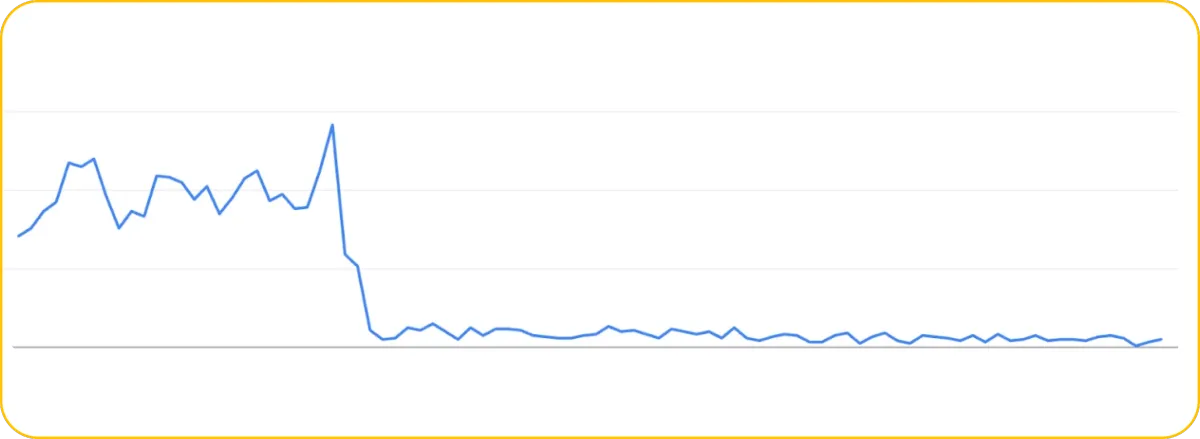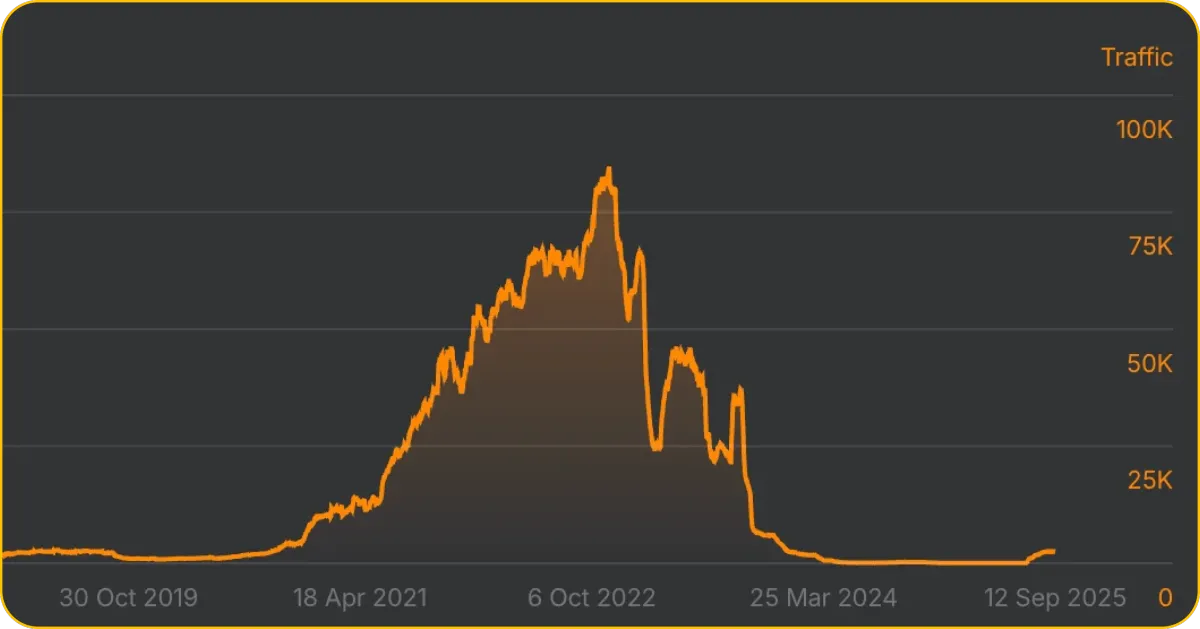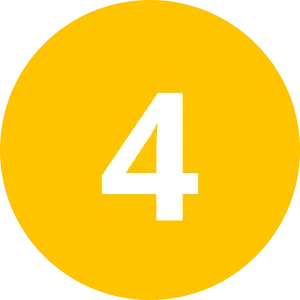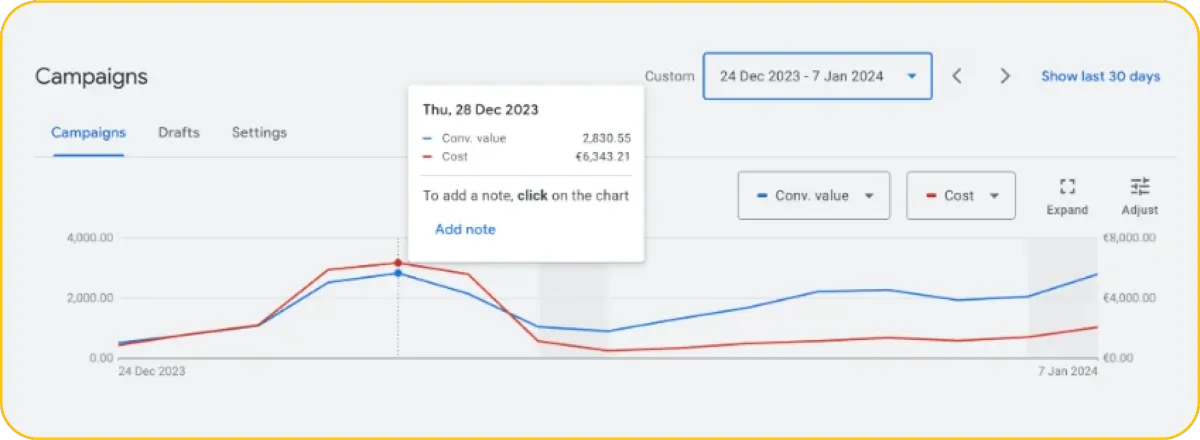

How I Went From Losing $40K Overnight to a $235K Month in 16 Months
October 01, 2025 • Nielszee
When I logged in after the 2nd Google Helpful Content Update in September 2023, I know exactly how I felt.
It was 09:30, I was in a new coworking spot in Amsterdam, ready to cowork with my buddy who has a SaaS and I saw an anomaly in my commissions. I logged into Google Search Console and saw graphs for 5 of my 6 websites like this…

I just lost €40.000 in monthly commissions from SEO. Thoughts started racing.
“Do I have to let go of all of my staff?”, “Does my business still have a right to exist?”, “Should I just quit and do something else?”.
I took a breath in, and breath out. “It already happened, take it easy,” I told myself. I called my co-founder about what just happened and we went into ‘full emergency mode’, analysing all our competitors and the whole industry to come up with a plan of attack to recover.
After two sleepless nights and analyzing all my competitors in the market, I noticed: even the sites that played by all of Google’s rules and had simply the best content, still got hit.
The game changed.
SEO used to be ‘certain’, but now Google can pull the rug underneath me whenever they want. If I ever want to sell my company, I can’t rely on organic traffic.

Another graph that resembles one of my sites. This site got hit both in HCU #1 & HCU #2.
Luckily, this story has a good ending. A year and a half later, we just had our record month of €235.000 in commissions with our best ever profits.
I knew what it was like to lose it all to SEO, but saw the potential to recover what I had built, and earn even more.
This case study is a snapshot of how to recover from SEO losses and transition into Google Ads. It’s a roadmap on how to look at a giant like Google in the face and figure out a way to make Google work for you, not against you.

How did we end up doing better after the HCU?
HCU felt like the nail in the coffin for many. For a moment, I had considered if it was also my end moment. But it was the next series of steps that allowed me to get out of that frame of mind and into an action plan to recover.

Step 1: Realization

Step 1: Realization
SEO alone is too fragile, Google’s incentives are with ads. Let’s not fall for that ‘We want to organize the world's information and make it universally accessible and useful’ mission statement of theirs. Meanwhile, they made $224 billion in ad revenue in 2022,($264 billion in 2024), letting everybody choose to ‘prefer’ their information by paying them via Google Ads.
The returns for SEO for my niche just changed. I needed to pivot. We identified Google Ads as the most logical solution since it’s closest to SEO.

Step 2: Strategy

Step 2: Strategy
I restructured my portfolio to integrate Google Ads, repurposing my highest-performing SEO pages into campaigns. I didn’t need to create new content, I just needed to bid on the same money keywords I was already ranking for.
Going from SEO to Google Ads, you already have 90% of the ingredients.
Content with clear intent matching of the keywords
Data about the best offers
Knowledge about what pages perform best
Keywords to mine from Google Search Console
A team to support page optimization
Contacts with affiliate managers of your best offers
Thanks to the affiliate tracking software WeCanTrack we were able to see exactly how much revenue each page made, what the average earnings per visitor (EPV) were and what products bring in the most commission (based on the earnings per click (EPC).
EPV is key here. To figure it out, divide the amount of visitors by the total revenue of the page to get the EPV. The EPV is your average earnings per visitor. We used that number to start our first search campaigns with exact keywords in Google Ads.
These first campaigns gave us promising data. But it wasn’t quite yet where we wanted it to be. Here’s what worked for us, and what plan of action I’d suggest if you want similar results.

Step 3: Systems & Metrics

Step 3: Systems & Metrics
In order for us to systematically grow we needed to three things:
1. Know what's working
2. Push it harder
3. Get paid better for it

Know what’s working
Push it harder
Get paid better for it
Know what’s working
Use affiliate revenue tracking software. Like WeCanTrack, Voluum or Affilimate. However, make sure the data is as accurate as possible.
Affiliate tracking software like WeCanTrack connects most of your affiliate programs, but often not all. That means if you have one product on the page, which is not tracked, you should estimate how much of a % you’re missing. Google Ads might show that your return on investment is 90% (so -10% loss), but since you mention that product first thing on your page, it might generate 50% of the sales of the page, doubling the conversion value you see in Google Ads, making your ROI 180% (+80% profit). If you only look at the Google Ads data, you might’ve paused the campaign.
Now, with the essential data you have the ability to focus on three key metrics:
1. Revenue per page
One of the biggest unlocks for me was realizing that more traffic isn’t always the answer. What matters is what that traffic does.
You might have a page getting 10,000 visits/month… and making almost nothing.
Then another page with 800 visits/month… and it’s quietly earning €500/month.
So stop guessing. Start tracking. These tools give huge ROI. Just figure out which pages, topics and content outlines are making you money, and which ones aren’t.
Push it harder: Go to your content backlog and based on the data of your current revenue per pages, focus on the winning topics and delete potential losers that you predict will make less of a return. Topics that do well in SEO don’t always do well in Google Ads. Separate that data.
2. Earnings per Visitor (EPV)
Divide the amount of visitors by the total revenue of the page to get the EPV. The EPV is dependent on the niche, offer, and the conversion rate of the page.
Push it harder: With this data you can see what content outlines, offers, and niches work best. Implement what works on other pages.
3. Earnings per Cl-ick (EPC)
EPC is the metric to compare what offers on your page are the best for you. For this you need to know how much every offer brings in and how much it is clicked. Divide the commissions by the clicks and you get the EPC.
Push it harder: To increase the revenue of your page, you want the product with the highest EPC at the top of your page and promoted the most.
Put your top products right at the top (use a “quick list” or summary table)
Move low-performing products down, or remove them entirely
Test different orderings and see what happens
Get paid better for it
When a product is working, ask for a better deal. You’re generating sales. You’re helping their business. That gives you leverage. Even a 2–3% higher commission rate all go fully to your profit margins and are essential to keep your business running.
But you won’t get it if you don’t ask. Mention what you can do for the brand (newsletter promotion, rank higher on page, create Youtube videos, etc.), what your current sales is for the brand and for the whole product category and what your future growth plans are. Put that all in Claude and ask it to write an email to ask for a higher commission.
The best thing to mail them is real data. Data about how many visitors, sales or product revenue the page generates and what that means for them are pretty tough to ignore. This may open the door to commisison rates that are gamechangers for your bottom line.

Step 4: Execution

Step 4: Execution
It took us just two months to be in a better position before than after the €40k loss in organic profits. Two months to add €40k to our bottom line. And that was just the beginning.
In order to setup our Google Ads, we didn’t just work a lot in Google Ads, coming from SEO, we needed to turn our SEO pages into 100% conversion focused pages.
Yes, you might get revenue from Google Ads on your SEO focused page, but if you want to 2x your revenue, turn it into a CRO optimized page. My friend in the VPN space uses these pages to gain SEO traffic and these to get Google Ads conversions.
SEO is about user intent, content depth, EEAT signals, and time on page.
Google Ads is about clicks and conversions.
Here’s my view I haven’t heard anybody else talk about before:
“I believe there’s a fundamental difference between a visitor from Google Ads vs. SEO”.

“I believe there’s a fundamental difference between a visitor from Google Ads vs. SEO”.

Someone from Google Ads knowingly didn’t take the 0.5 seconds of effort to scroll down to the organic results. They clicked on an ad while knowing it’s an ad. These people just want to make a decision NOW. So as long as you make it as clear as daylight and as easy as possible (contrastful buttons, easy to read, trust signals, clear icons) for the person to make a decision, then they will convert right this minute.
Meanwhile, organic visitors actually do the effort to scroll down, read your content and, do the research.
So adjust your pages for Google Ads visitors. We help people in this process from our meaningful experience as well.
On the road to getting to our €235k month in Google Ads, we made many mistakes over the past years. There are many more intricacies, but these are the ones to easily avoid:
Don’t let people without affiliate marketing (or lead generation) knowledge handle your account blindly. When outsourcing Google Ads, you need someone with either affiliate marketing or lead generation experience. Unless you’re going to onboard and hand hold them heavily. Else you can’t give them free reign over your account. People unknown to affiliate marketing have the tendency to just switch everything over from the campaign setup that worked ‘for their ecommerce client’, while you’re not in ecommerce… you’re an affiliate with more thin margins, the game is different. Someone that has PPC affiliate marketing experience is best, lead generation experience is second best.
Don’t think losers will turn into winners by itself. It’s very easy to spend a lot of money on Google (just wait till you read the next part), so you need to be careful. A page having high EPVs or revenue from SEO is not a guarantee that the same will be for Google Ads.
Campaigns that have had significantly enough clicks to have at least a few conversions, but are still making a loss, don’t need more data, the page needs to be improved, the keywords need to be changed or it needs to be paused. If you already applied your ‘perfect campaign setup’ and the initial data is bad, just pause it and move on.
Don’t use ‘maximize clicks’ without total budgets and max CPC budgets. One freelancer in our team wanted to ‘get the data going’ with Maximize clicks so around Christmas (the one time I don’t check the data for a few days), we’ve made calculated losses of around €15k versus what we’d normally earn with this move. When you give Google the opportunity to spend a lot of money, they will grab that opportunity. Be frugal. Be careful.
Don’t let people without affiliate marketing (or lead generation) knowledge handle your account blindly. When outsourcing Google Ads, you need someone with either affiliate marketing or lead generation experience. Unless you’re going to onboard and hand hold them heavily. Else you can’t give them free reign over your account. People unknown to affiliate marketing have the tendency to just switch everything over from the campaign setup that worked ‘for their ecommerce client’, while you’re not in ecommerce… you’re an affiliate with more thin margins, the game is different. Someone that has PPC affiliate marketing experience is best, lead generation experience is second best.
Don’t think losers will turn into winners by itself. It’s very easy to spend a lot of money on Google (just wait till you read the next part), so you need to be careful. A page having high EPVs or revenue from SEO is not a guarantee that the same will be for Google Ads.
Campaigns that have had significantly enough clicks to have at least a few conversions, but are still making a loss, don’t need more data, the page needs to be improved, the keywords need to be changed or it needs to be paused. If you already applied your ‘perfect campaign setup’ and the initial data is bad, just pause it and move on.
Don’t use ‘maximize clicks’ without total budgets and max CPC budgets. One freelancer in our team wanted to ‘get the data going’ with Maximize clicks so around Christmas (the one time I don’t check the data for a few days), we’ve made calculated losses of around €15k versus what we’d normally earn with this move. When you give Google the opportunity to spend a lot of money, they will grab that opportunity. Be frugal. Be careful.

Don’t trust Google account managers. These people’s sole job is to get you to spend more. They have hefty bonuses related to your spend. So all they’re going to do is sell you new services. “You should really try Display Advertising”, “Many of your colleagues are successful with Video ads”, “Demand Gen will allow you to reach new highs”. I’ve never experienced or heard from someone in the space that these account managers were actually useful.

Step 5: Results

Step 5: Results
The fast feedback loop is something I’ve never experienced before. It’s just so refreshing to be able to get such fast results in a month, instead of the slow ramp-up period of SEO.
After 3 months, we got that €40k back. And not just revenue, but profits.

This is the revenue of my affiliate portfolio. With peaks in Jan/Feb, because that’s when I get commissions from Black Friday/Christmas, which is peak season for us.
We’ve had ‘the luck’ that some of our sites got hit by HCU #1 and we already tried out Google Ads on our SEO pages. However, between HCU #1 and HCU #2, we used exactly the same pages for both SEO and Google Ads. HCU #2 allowed us to go full in on Google Ads.
There’s still some ups and downs, mainly due to the aforementioned mistakes we made. The team handling your ads is so important, every time we made hiring mistakes, our revenue dropped, because the campaign setup for affiliates is so unique.

Introducing AffRamp
For the past years I’ve been preaching this to many of my international friends and pushing them to start in Google Ads as well. What I always hear is that they don’t know:
1. How to hire the right people and hold them accountable
2. They don't want to touch a new channel and learn everything
3. They don't have the time to do 1 & 2

How to hire the right people and hold them accountable

They don’t want to touch a new channel and learn everything

They don’t have the time to do 1 & 2
That’s why I started AffRamp. To solve this without giving any risk to the publishers. I know this model works and that’s why I only want to get paid for results.
If you’ve made €25K at some point in your affiliate journey, you already have what’s needed: the content, the rankings, the team. With Google Ads, we can replicate and scale that revenue again, because we’re bidding on the same money keywords your content already targets. The ceiling you once hit isn’t the end, it’s the foundation for an even higher ceiling. And if you read this far, you now know exactly how far it can go.
We replaced more than our SEO traffic with SEO. That’s why we only work with people who earn or have earned €25.000 a month, because we know we can match that with Google Ads as well.
If you’re ready to reach the next level of your business and reclaim the revenue you thought was gone or just want to have a relevant business in two years time, I fully believe this is the path forward.
Not only will you profit from Google Ads when working together, the higher commissions, new systems and revenue diversification, will make you feel a lot better about the future as well.

© Niels Zee 2025 all rights reserved